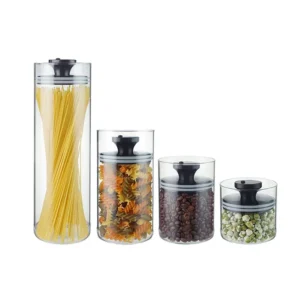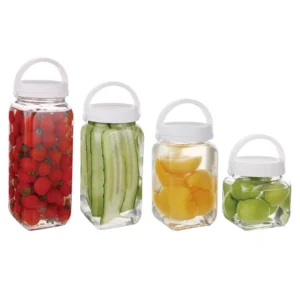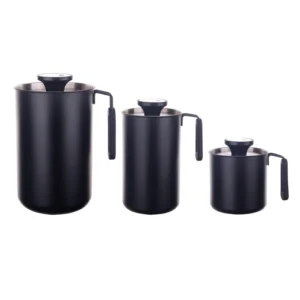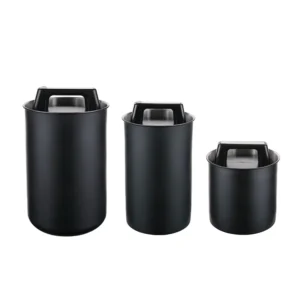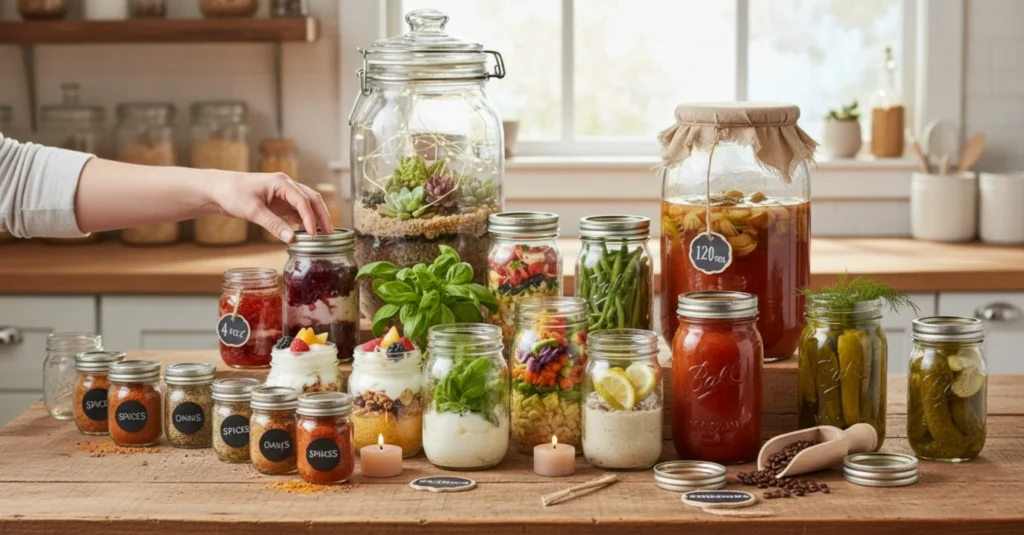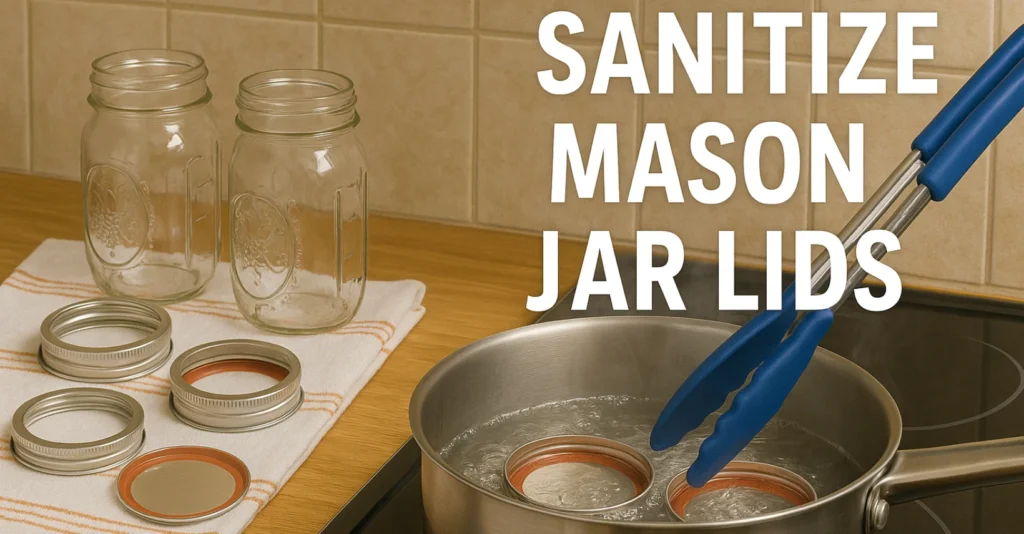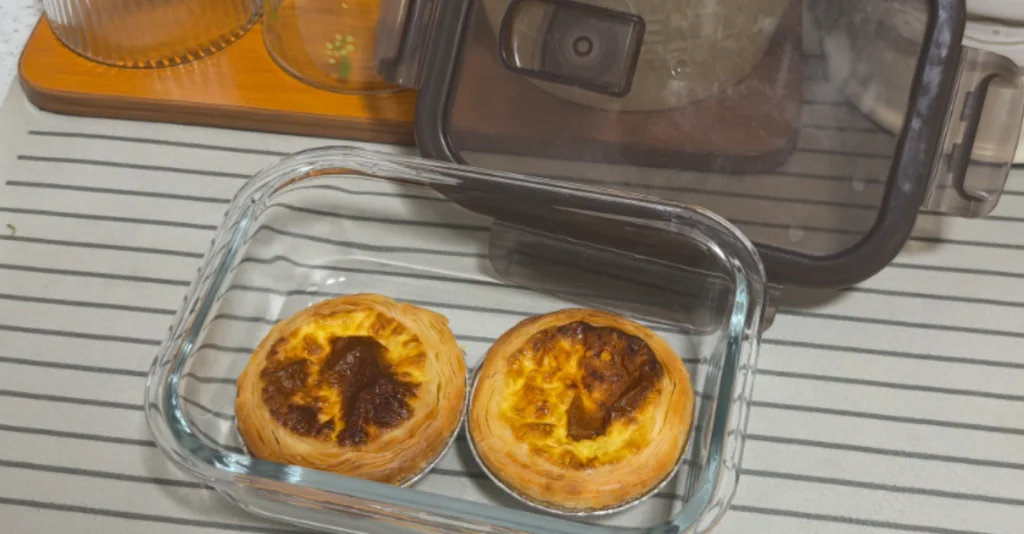A Ticking Time Bomb in Your Kitchen? Most of us use plastic food containers without a second thought. But research has revealed a disturbing truth: the convenience of plastic often comes at a cost to your health and the environment. These containers, especially when heated, can leach harmful chemicals into your food. Healthy and non-toxic food storage container materials are particularly important. Let’s take a look at which 6 safest food storage containers’ materials can help you conquer your kitchen challenges. This guide will introduce you to a new way of thinking about food storage. We’ll break down the six safest materials and provide a clear roadmap to a healthier, more sustainable kitchen.
Why Plastic is Out?
The Material of Plastic
Plastic is a synthetic material derived primarily from fossil fuels like petroleum and natural gas. To create a wide array of products, various chemicals are added during manufacturing to give plastic specific properties, such as flexibility, durability, and color. These additives often include substances like phthalates, which make plastic soft and pliable, and bisphenols (e.g., BPA), which make it hard and shatter-resistant. The problem is that these chemicals are not permanently bound to the plastic and can leach into food and liquids, especially when exposed to heat, fatty foods, or acidic substances.
Impact on the Earth’s Ecology
Plastic’s greatest environmental flaw is that it is not biodegradable. Instead of decomposing, it breaks down into progressively smaller fragments called microplastics and nanoplastics.

- Pollution: Millions of tons of plastic waste enter oceans, rivers, and landfills each year. It is a major driver of biodiversity loss and poses a direct threat to wildlife through ingestion, entanglement, and suffocation.
- Soil and Water Contamination: Microplastics have been found in every corner of the planet, from Antarctic snow to human blood. As plastic breaks down, it releases the same harmful chemicals that can contaminate soil and water sources, affecting ecosystems and wildlife.
- Climate Change: The entire lifecycle of plastic—from the extraction of fossil fuels to its production and disposal—releases significant amounts of greenhouse gases, contributing to global warming.
Impact on Human Health
The chemicals that leach from plastic are a major concern for human health. Many of these compounds are classified as endocrine disruptors.
- Hormone Disruption: Bisphenols (BPA, BPS) and phthalates can mimic or interfere with the body’s natural hormones, potentially leading to issues with reproductive health, development, and an increased risk of certain cancers, obesity, and metabolic disorders.
- Microplastic Ingestion: The tiny plastic particles that break off of containers can be ingested, and microplastics have been detected in human blood and organs. While the full long-term effects are still being studied, they have the potential to carry toxic chemicals and cause inflammation.
- Toxicity: Other chemicals like styrene (found in polystyrene foam) have been recognized as potential carcinogens.
The Plastic Material Paradox
“BPA-free” isn’t a guarantee of safety because of a concept known as regrettable substitution. This means that when a chemical is identified as harmful and phased out, it’s often replaced with a very similar, or “chemical cousin,” that may have the same negative effects.
The Problem with Bisphenol Substitutes
- Chemical Mimicry: Companies commonly replace BPA with other bisphenols, such as BPS (Bisphenol S) and BPF (Bisphenol F). While structurally slightly different, these chemicals share a similar molecular structure with BPA, allowing them to also mimic hormones in the body.
- Endocrine Disruption: Like BPA, BPS and BPF have been shown in numerous studies to act as endocrine disruptors. They can interfere with the body’s hormonal signaling, potentially affecting the reproductive system, metabolism, and brain development. In some studies, these alternatives have even been shown to be as potent as or more harmful than BPA.
- Health and Environmental Impact: Research has found that BPS can have similar effects on hormonal activity as BPA and is more resistant to environmental degradation, meaning it can persist in the environment for even longer. They have been detected in human urine at similar frequencies to BPA, highlighting widespread exposure.
This is why a complete move away from all plastics for heating and long-term storage is the safest choice. The “BPA-free” label, while seemingly reassuring, does not address the fundamental issue of plastic’s potential to leach harmful, hormone-disrupting chemicals.
What “Non-Toxic” Truly Means
Non-toxic food containers are if it’s free from substances that can cause harm. In food storage, this means no leaching of endocrine disruptors like BPA (Bisphenol A), BPS, and phthalates, which can interfere with your body’s hormonal system. Choosing the best non-toxic glass food storage containers materials is about ensuring the food you prepare stays pure and healthy.
Plastic is “out” as a food container material due to its significant negative impacts on human health and the environment, stemming from its material composition and disposal issues. While it offers convenience and low cost, the long-term consequences have led many to seek safer alternatives.
6 Kinds of Safest Food Storage Containers
The move away from plastic food containers is a necessary step to protect both our health and the environment. Here are six of the best non-toxic food storage containers’ materials. Let’s learn more about the best storage containers for food.
1. Glass: The Transparent Champion
- Why It’s Safe: Glass is divided into borosilicate food containers and soda lime food containers, either glass will be safer than plastic. Glass is made from natural materials and is completely non-porous. It doesn’t stain, absorb odors, or leach any chemicals into your food, no matter how hot or cold it gets.
- The Pros:
- Versatility: Safe for the oven, microwave, dishwasher, and freezer.
- Longevity: Extremely durable and can be reused infinitely.
- Clarity: You can easily see what’s inside, reducing food waste.
- The Cons:
- Breakability: Can shatter if dropped.
- Weight: Heavier than other options, making them less ideal for some on-the-go uses.
- The Lid Problem: This is often the weakest link. Look for containers with lids made of stainless steel or high-quality, BPA-free silicone. Avoid plastic lids, especially when heating, as they can still leach chemicals.
Recommended products
2. Stainless Steel: The Indestructible Fortress
- Why It’s Safe: Stainless steel is a non-reactive metal, meaning it won’t corrode or leach chemicals into your food. It’s a workhorse known for its incredible durability.
- The Pros:
- Lightweight & Portable: Perfect for packing lunches and on-the-go meals.
- Virtually Indestructible: Won’t break or dent easily, making it a great alternative to plastic for kids’ lunches.
- Thermal Properties: Keeps food cold for hours.
- The Cons:
- No Microwave: Cannot be used in the microwave.
- Opaque: You can’t see the contents without opening the lid.
Recommended products
3. Food-Grade Silicone: The Flexible Innovator
- Why It’s Safe: Unlike plastics, high-quality silicone is made from sand and oxygen. It’s a non-porous, non-toxic polymer that is extremely durable and flexible.
- The Pros:
- Versatile: Safe for the freezer, microwave, oven, and dishwasher.
- Space-Saving: Many silicone containers are collapsible, making them ideal for small kitchens.
- Bags and Wraps: A fantastic, reusable alternative to single-use plastic bags and wraps.
- Identifying High-Quality Silicone: Look for “100% Food-Grade Silicone” or the silicone “pinch test” (if it doesn’t turn white when you pinch it, it’s pure).
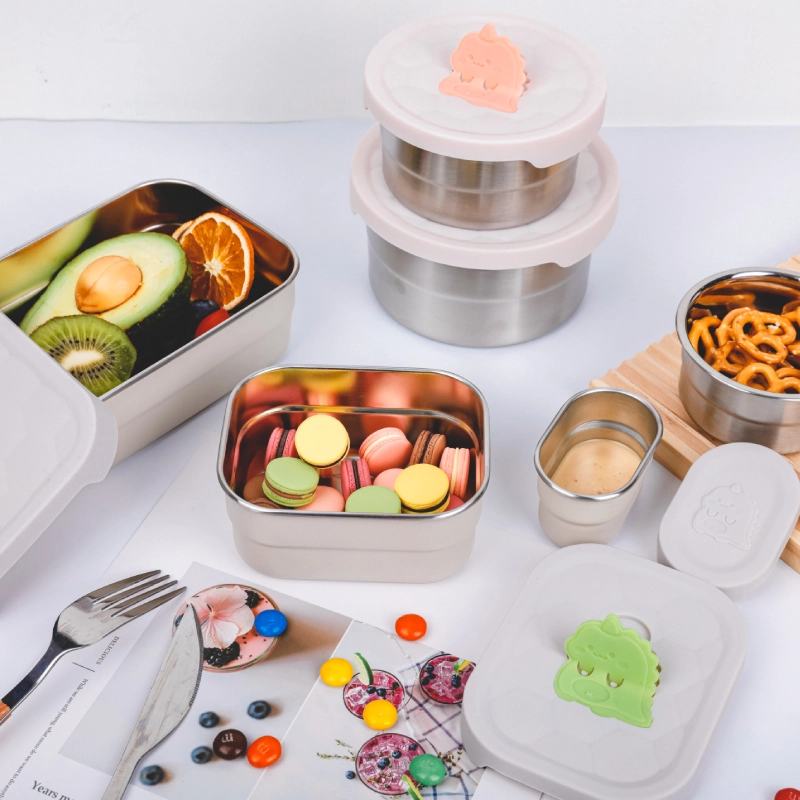

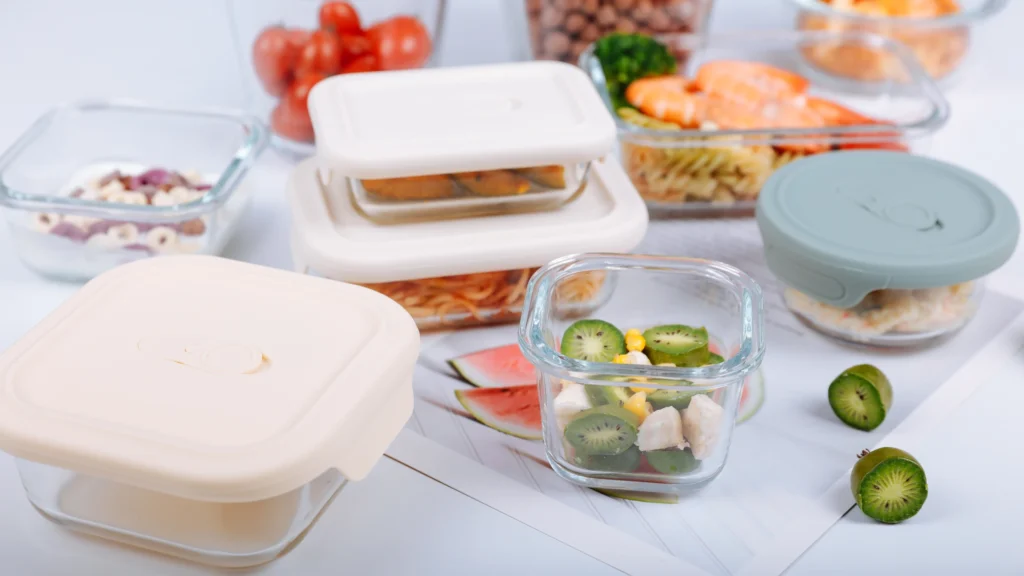
4. Ceramic & Stoneware: The Pantry Powerhouse
- Why It’s Safe: As natural, ancient materials, ceramic and stoneware are excellent for storing dry goods. They are free from plastics and provide a beautiful, old-world aesthetic.
- The Pros:
- Aesthetic Appeal: Adds a rustic and organized look to your pantry.
- Temperature Stability: Excellent for slow, even heating in the oven.
- Breathability: Unglazed ceramic can help keep produce like garlic and onions fresh.
- The Non-Toxic Factor: The key is to ensure the glaze is 100% lead-free and free from other heavy metals. Always check the product description or the manufacturer’s website.
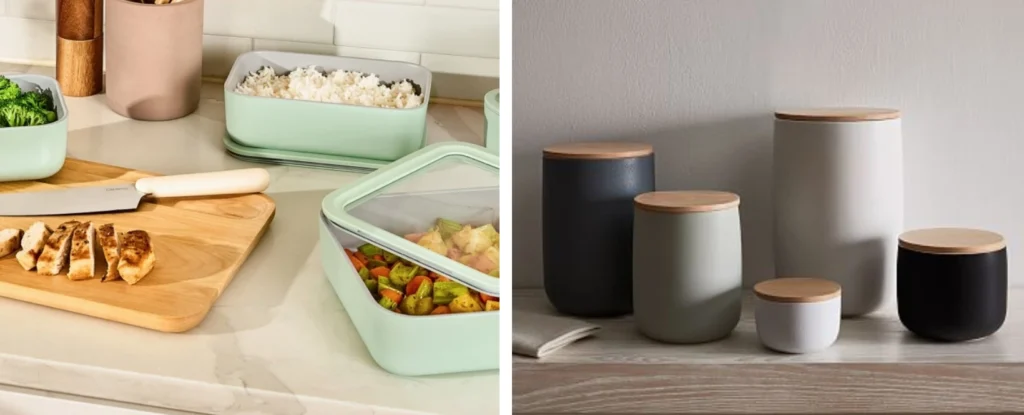
5. Wood: The Natural Storage Solution
- Why It’s Safe: Untreated, food-grade hardwoods are a sustainable and naturally beautiful option. Wood is non-toxic and provides a natural way to store certain foods.
- Best Uses: Bread boxes (wood helps regulate moisture), salt and spice cellars, and fruit bowls.
- Care and Maintenance: Wood is not suitable for moist foods or liquids. It requires occasional oiling with food-safe mineral oil to prevent it from drying out, cracking, and growing mold.
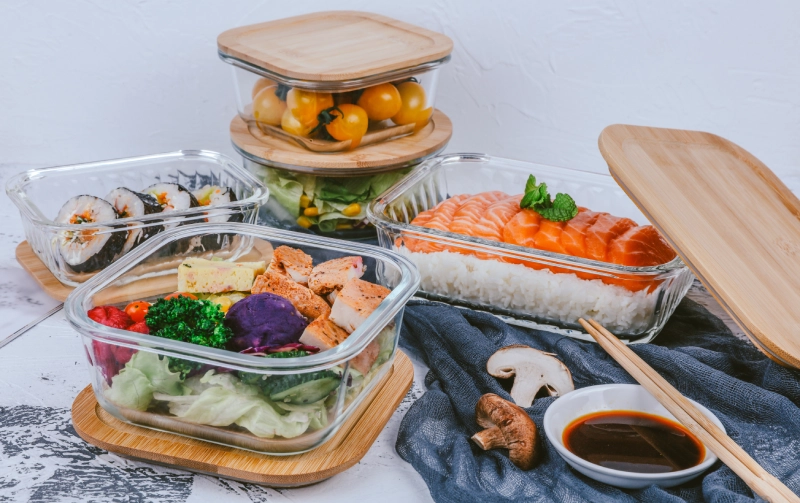
6. Beeswax Wraps & Cotton Bags: The Zero-Waste Wrapper
- Why They’re Safe: Made from natural materials like beeswax, jojoba oil, and cotton, these wraps and bags are a reusable and biodegradable alternative to plastic wrap and zipper bags.
- Best Uses: Wrapping sandwiches, cheese, and vegetables. Cotton bags are perfect for produce and bulk dry goods.
- Care and Longevity: Hand wash in cold water with a gentle soap. With proper care, they can last for over a year. At the end of their life, they can be composted.
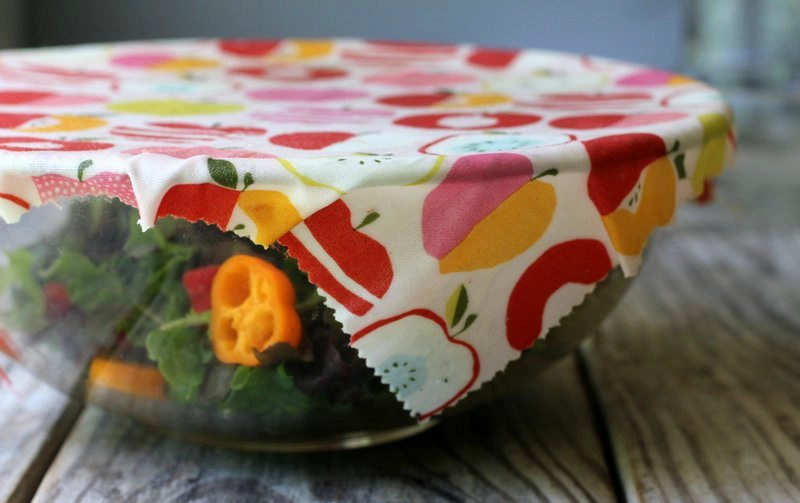
Conclusion: Making the Switch is a Revolution
The above materials are the 6 safest food storage containers. Your journey to a healthier kitchen is a powerful one, and it starts with a simple choice. By transitioning away from plastic, you’re not just protecting your food—you’re making a direct investment in your health and the health of the planet. The six materials we’ve explored—glass, stainless steel, ceramic, food-grade silicone, wood, and beeswax wraps—offer a clear path to a safer, more sustainable way of living. They prove that you don’t have to sacrifice convenience for peace of mind.
Ready to make the switch? As a trusted supplier of high-quality tableware, we’re here to help you get started. Explore our collection of non-toxic meal prep containers and discover the perfect solutions to store, heat, and enjoy your food safely. Transform your kitchen and join the revolution for a cleaner, greener future—one container at a time.

